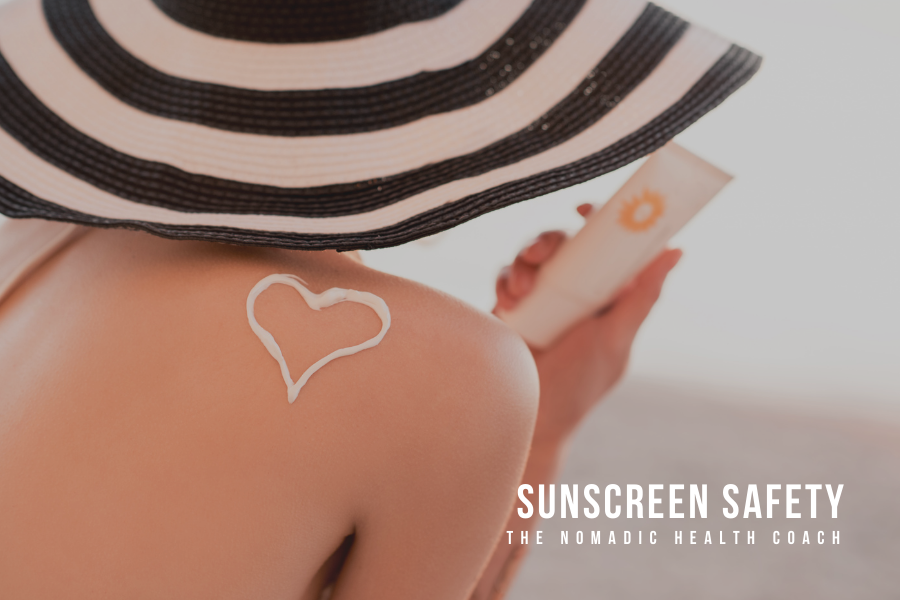Are all sunscreens safe?
Summer is right around the corner and many of us have been cooped up for months. Our skin is tender and pale and it’s inevitable we’ll get a burn the first few times we are outdoors. Many of us pick up our sunscreen products at Target, Walmart or other convenience stores but we never really think to question; are sunscreens safe for us? Are they safe for the environment? We should never assume the answer to either is yes.
The FIRST thing you need to do is throw away your sunscreen from last year and pick up a fresh supply. Sunscreens expire and loose their efficacy and protection qualities. So even if your slather on an entire bottle of SPF 50, you still have a high risk of getting burned.
Just stock up every spring and you’re good to go.
Every year the Environmental Working Group (EWG), and their team of scientists, investigates and tests hundreds of sun protection products on the market. In spring of 2019 the results found that over two-thirds—of 1300 sunscreens tested—offered inadequate protection, caused reactions on the skin, or contained worrisome chemicals like oxybenzone, a hormone disruptor that is readily absorbed by the body. Many of us don’t give sunscreens too much attention but after reading their findings, we should all take notice. We apply sunscreen to large portions of our bodies, several times per day and typically for several days or weeks in a row. And for those of us who live in the south, we can multiply that exponentially.
To help adhere to the skin, sunscreen ingredients soak directly into our skin by way of “penetration enhancers” (aka nanotechnology) and have been detected in human blood, urine and even breast milk. This is concerning if you are trying to get pregnant, are pre/post menopausal, or have any type of estrogen dominance concerns. And it’s equally concerning for young children and teens in the developmental stages.
Over time, chemicals bioaccumulate in our bodies. With continued use they can be the cause of many hormonal issues and allergic skin conditions that can last a lifetime. Ingredients in sunscreen shouldn’t be irritating or cause any type of skin allergies. They shouldn’t be affecting our hormones yet several commonly used ingredients, including oxybenzone, appear to block or mimic hormones. With sunscreen sprays becoming increasingly popular, they also shouldn’t be harmful to our lungs or internal organs when we accidentally inhale when the wind shifts direction mid-spray. And sunscreen ingredients should be able to withstand powerful UV radiation without losing their effectiveness.
Sunscreens and the Environment.
According to the National Institute of Health (NIH), sunscreen ingredients have been found in almost ALL water sources around the world. Disturbingly, they are not easily removed from wastewater treatment facilities. Additionally, in lab settings, oxybenzone has been implicated specifically as a possible contributor to coral reef bleaching. UV filters such as 4-methylbenzylidene camphor, oxybenzone, octocrylene, and octinoxate—other sunscreen ingredients—have been identified in various species of fish, algae, sea urchins and mammals worldwide. According to the NIH, all of this has possible consequences for the food chain.
This is really something for us to think about when we are enjoying the outdoors. We need the sunscreens to protect us from harmful UV rays yet we are inadvertently causing a consequential impact on the environment.
Until there are more in-depth and thorough studies, it’s wise to use the “precautionary principle.” Ingredients that are meant to keep us protected shouldn’t be putting our bodies and planet at risk and we need to remember that we have a choice in the matter.
Steps You Can Take
- Start reading labels and stay away from any products containing oxybenzone (note that it can also be in your make-up!)
- Understand that the FDA doesn’t regulate the beauty and personal care industry which means manufacturers can create products without testing for their safety. This isn’t just about sunscreens, it’s also about every beauty, skin hair and body care product we use.
- Read the EWG’s Annual Guide to Sunscreens and learn more about the concerns about sunscreen ingredients.
"For 40 years, American's have been told that sunscreen use is critical to prevent lasting skin damage and skin cancer from sun exposure. But the FDA has not ensured that the ingredients meant to provide such protection have been adequately tested for safety and efficacy."
~ EWG
The good news is…that’s all about to change. The FDA is considering new regulations that would help ensure that ALL sunscreens are safe and effective and finally proposing sufficient testing for the active ingredients in sunscreens to test for absorption rates and health impacts. And it’s about time. As of right now, the FDA recognizes as safe and effective just two ingredients, zinc oxide and titanium dioxide. In the past, these two ingredients would leave our skin looking white and greasy when we applied them but new technology has significantly improved how these products perform. Mineral sunscreens using these two safe ingredients now glide over our bodies and leave no residue and film.
Until these regulations are in effect, here’s what you can do to stay safe and healthy this summer—and beyond.
- Avoid products that claim an SPF higher than 50+.
- Avoid spray and powders which can penetrate into the lungs.
- Choose sunscreen products made with zinc oxide and titanium dioxide—and avoid oxybenzone. You can order many brands online (see below for my recommendations) or find many options at a natural food market such as Whole Foods, Fresh Thyme or your local co op.
- Turn your products around and always, always, always read the ingredient labels. Most everything on the front of a product is marketing. Remember there is no regulation!
- Look up your sunscreen in the EWG Skin Deep Database to see how it ranks for toxicity.
MY SAFE SUNSCREEN RECOMMENDATIONS:
- Beauty Counter—Highly recommend. I can’t say enough good things about this company and the safety and efficacy of their products. Beauty Counter has the highest safety standards in the industry.
- SunBum—I love this brand because it doesn’t clog pores and is non-greasy which means we can apply our foundation right after we apply it.
- Badger—highly reputable company for safe and healthy products.
- Pacifica—I am loving their SPF 50 Bronzing Butter for my pale legs!
And a Few Tips:
- If you are going to be spending a good amount of time outdoors or are on vacation; upon waking up, apply sunscreen to your face and body right away! I wash my face, brush my teeth, apply sunscreen and then get dressed. I can’t tell you how many sunburns I have avoided by doing this!
- When using spray sunscreens, always spray it into palms and then rub onto skin or make sure you are “downwind” as you spray (and hold your breath.) This also eliminates overspray and wasting of product!
(Please note: The EWG is a watchdog organization that depends on supporter donations. When you click on any of the links I’ve provided, they will ask for a donation. Simply click on the X and continue to the site or feel free to support their important work with a contribution.)
SOURCES:
https://www.ncbi.nlm.nih.gov/pubmed/29981751
http://www.marinesafe.org/blog/2016/03/18/sunscreen-pollution/
https://www.ewg.org/sunscreen/report/the-trouble-with-sunscreen-chemicals/
https://www.ewg.org/sunscreen/report/executive-summary/
https://www.ewg.org/sunscreen/report/nanoparticles-in-sunscreen/




